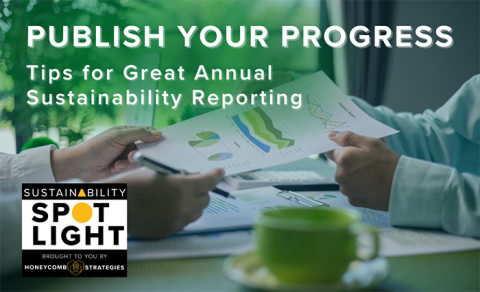Publish Your Progress: Tips for Great Annual Sustainability Reporting

Exclusively sponsored by Honeycomb Strategies
An annual sustainability report is more than just a compliance document—it’s a blend of hard data and compelling storytelling that can be another tool to help advance your sustainability goals. Sharing your progress can encourage internal and external parties to join the cause or redouble their efforts and can act as an annual check-in for the programs you’ve started. In addition, public sustainability reporting increases transparency, strengthens governance, keeps companies accountable, and inspires others. Reporting can enhance a brand’s value and attract partners and sponsors who may align with your mission. Here’s how to make your report impactful and engaging:
Set Clear Goals
Begin by sharing or revisiting your company’s sustainability goals and commitments. Highlight if there have been any updates or changes. Executive support plays a crucial role in framing the importance of sustainability reporting, so a message from leadership can reinforce your organization’s commitment.
Show the Receipts
When used in the proper context, data can tell a powerful story. Explain what you’re measuring and why it matters. If you report significant increases or decreases, explain these changes. Visual elements such as icons, pictures, or infographics can assist stakeholders with tracking progress and understanding your conclusions.
Consider aligning the data with established sustainability frameworks such as the UN Sustainable Development Goals (SDGs), the Net Zero Carbon Events Initiative, ISO 20121, or your company’s environmental management plan.
As you progress through an ongoing program, you’ll want to demonstrate year-over-year progress. What worked well? What milestones did you achieve? Make sure to include how your sustainability programs and initiatives led to these results, so they appear intentional instead of random.
Transparency is essential in your report. While you don’t have to disclose every challenge or pitfall, it is important to acknowledge areas where improvement is needed to build trust and credibility. Have you identified any blind spots, or did an initiative fall short of expectations? Benchmarking in this industry can be very challenging: did you encounter any data gaps? Honest reflections help avoid greenwashing and show a commitment to continuous progress.
Storytelling
Although data might provide the foundation of a sustainability report, storytelling brings it to life. Share narratives about improvements, the effort behind your initiatives, and the lessons learned along the way. Even if your goals weren’t fully met, highlighting progress shows persistence—something that resonates with customers, investors, and partners.
Storytelling can include:
- The year-over-year journey to show how far you’ve come.
- Spotlighting champions, leaders, or teams that have driven meaningful change.
- Demonstrating values-based connections—how your company embodies its sustainability commitments.
- Engaging comparisons, such as “what we said we’d do” vs. “what we achieved”
- Showcasing partnerships and community involvement—who did you collaborate with or support this year?
- Internal check-ins—insights from different departments such as operations, events, and facilities.
Sustainability is an ongoing journey. Conclude your report by outlining future goals and your plans for achieving them. A forward-looking perspective ensures stakeholders see your commitment to ongoing improvement and long-term sustainability.
Select the Platform
Be thoughtful about where you are sharing your document and with whom. A dedicated sustainability section on your website is a great strategy, as is a dedicated press release and/or conference about the biggest takeaways. Make sure you’re sharing the reporting internally with your organization as well, distributing through team meetings, trainings, and shared drives or intranet.
You should be prepared to answer questions about your data if they come up. Establish a forum for feedback, whether that is providing a contact email, comment section, or public presentation to clarify lingering questions. And be responsive to questions, even the hard-hitting ones, using them as encouragement to continue your journey.
The Bigger Picture
Sustainability is an opportunity to prove to shareholders that there has been a return on investment in sustainable initiatives and a benchmarking tool for internal evaluation. A well-structured report can serve as a powerful marketing tool, showcasing your company’s commitment, progress, and impact. By blending transparency, data, and storytelling, your sustainability report can become an asset that engages stakeholders and drives meaningful change.
Honeycomb Strategies specializes in impactful solutions for sustainable events, sports, and venues. hcsustainability.com / [email protected]


Add new comment